
|
|
Mythical Mills - the Mills 1.3 “Anniversary Model” Readers of my article on the Mills model diesels will recall that reference was made to a Mills 1.3 variant which has become generally known as the “Anniversary Model”. This variant was distinguished by its use of an aluminium alloy case which was machined in the same manner as the Mills 1.3 Mk. 2 magnesium-case models. It also featured provision for the mounting of a pair of exhaust stubs, although these are missing from most surviving examples. My good mate Maris Dislers presented me with a strong case suggesting that no “Anniversary Model” ever existed and that these aluminium-case engines are actually aero conversions of the almost forgotten Mills 1.3 Marine model which was released in June 1948 in parallel with the Mills 1.3 Mk. 2 Series 1 offering. I found Maris’s case to be quite compelling. The original intention was to roll Maris’s thinking into my existing articles, thus setting the record straight. However, on reflection I decided that a better approach would be to reverse the intended process by rolling some of my own thinking into Maris’s text, with appropriate reference changes being made to my previous Mills articles. I saw this somewhat revisionist view of the engine in question as something which was well worthy of its own independent discussion. So without further ado, here’s our joint take on this issue! The Mills 1.3 "Anniversary Model" - Did it Exist? By Maris Dislers with Adrian Duncan
It's our contention that this model was the rare variant with an aluminium crankcase, looking like the magnesium-case 1.3 Mk. 2 Series 1 model of June 1948 but with distinctive screw holes beneath the exhaust area. This variant's very existence has confused many model engine collectors, since it doesn’t fit neatly into the broader narrative. The confusion regarding this seemingly anomalous version of the Mills 1.3 evidently goes back to 1987, when Mike Clanford published his very useful but often misleading “Pictorial A-Z” book. In his book, Clanford included the attached image of an aluminium-case Mills 1.3 featuring the screw holes beneath the exhaust openings. Clanford claimed that this was one of a “few” such examples made in June 1948 and that the holes were created to facilitate the mounting of a pair of exhaust stubs (missing in Clanford’s photo). However, Clanford stopped short of designating this seemingly anomalous example as any specific model, either Anniversary or Marine. Its subsequent designation as an “Anniversary Model” was left for others. That particular designation appears to have originated in 1991, when the late Roger Schroeder sought to categorize the Mills engines for the "Engine Collectors Journal" (ECJ), working at arm’s length from the USA with the help of his many contacts. According to Roger, “friends from England” informed him that this oddball aluminium-case model was something called the “Anniversary Model” which was made only in June 1948. The date clearly originated with Clanford – the designation was a later embellishment. No supporting evidence for the application of the name was provided – Roger simply passed it on as an item of information supplied to him anecdotally by others. The designation has somehow stuck down through the years, even though we remain aware of absolutely no supporting evidence despite a good deal of hard looking. If any reader has such evidence, please share it with us! A review of the advertising history of the Mills engines fails to turn up any reference by the manufacturer to an “Anniversary Model” at any time, nor are there any contemporary media references to such a model. If an officially-designated "Anniversary Model" had been produced, surely Mills Brothers would have By contrast, a close look at “Aeromodeller” adverts from the time confirms the existence of a marine version of the Mills 1.3. Such an engine first appeared in the fine print of the Watkins advertisement of August 1948 reproduced at the right. It's instructive to note that the selling price of the marine model was cited as being "approx. £5 0s 0d". It would seem that supplies of the engine had yet to reach the dealers, leaving the selling price up in the air. Equally of interest, the flywheel was offered separately at a price of 7s 6d (£0.38). The engine continued to appear in Watkins ads The 1.3 Marine model was also featured in the Henry J. Nicholls placement of October 1948, where it was stated to be suitable for "boats or cars". These dealer advertisements appeared in advance of a more prominent Mills Bros. advert in December 1948 as seen at the left. This latter placement listed a “1.3 cc Marine complete with exhaust stubs and flywheel”, also asking readers to inform them of Mills-powered wins with airplane, boat or car. The cited exhaust stubs were formed from round metal tubing, flattened somewhat at the base and soldered to mounting flanges before being Watts nickel-plated against corrosion. The stubs were retained by two of the cylinder hold-down screws and one additional screw below the associated exhaust opening. The price of the 1.3 Marine was cited as £5 7s 6d (£5.38), somewhat higher than the £4 15s 0d (£4.75) asking price of the standard aero 1.3. Thereafter, the 1.3 Marine was mentioned as a one-liner in Mills advertisements in the January – May 1949 issues of “Aeromodeller”. The price was reduced a little to £5 5s 0d (£5.25) during this period. It's Maris’s contention, which I support completely, that the so-called “Anniversary Model” is actually nothing more than the Mills 1.3 Marine model retro-converted to aero use. Once again, if any reader has persuasive evidence to the contrary, please share it with us! it seems very likely that a significant stock of unused Mk. 1 aluminium crankcases remained when the magnesium-case Mills 1.3 Mk. 2 Series 1 was introduced. The idea of creating the marine engine was presumably hatched as a way of using up these left-over aluminium cases. The extra weight and lower power output of such a model were not important in marine service, while aluminium resists corrosion far better than the new magnesium alternative. This all fits in with the expanded range strategy as well as the Marine concept. Apart from their use of re-machined Mk. 1 crankcases, the Marine models used Mk. 2 crankshafts and carburettors. However, they retained the Mk. 1 piston/cylinder/rod assemblies to conform to the continuing use of the Mk. 1 crankcase. A few of the later examples appear to have been fitted with Mk. 2 pistons with their shorter skirts, thus increasing the induction period significantly. Given their distinctive design features, the marine engines were quite logically given their own serial number block, which was then well separated from the numbers assigned to the contemporary Mills 1.3 Mk. 2 Series 1 aero engine which appeared at around the same time. Those early magnesium-case aero models were numbered beginning at around 19000. Reported serial numbers for the aluminium case engines all lie within the 30002 - 30292 range, clearly implying that this is by far the In his final instalment of “The Mills Story” (Model Engine World, April 1996) Mike Noakes noted the December 1948 advertisement in “Aeromodeller, but did not associate the marine engine with the reputed “Anniversary Model”. His eagle eye spotted two later Mills adverts in November and December 1950 that included the 1.3 cc Marine unit “with fuel cut-out” selling for £4 2s 0d (£4.10) - a further price reduction. That model appeared for the last time in the January 1951 issue. The absence of any listings of the marine engine or suitable boat kits in contemporary dealer adverts suggests that this offering represented a final token effort by Mills Bros. for the Christmas 1950 season after a presumably dismal sales performance following the engine’s introduction in June 1948. Interestingly enough, the Mills parts lists for the period do not include any marine components. Aside from the 1.3 cc Marine as described, the marine Mills engines which are encountered today from time to time are not ex-factory, actually being With use in model aircraft being overwhelmingly more popular among Mills users, most surviving examples of these engines are now “bare”, having parted company with their exhaust stubs and being retro-fitted with regular aero spinner nuts. The one shown in Mike Clanford’s “Pictorial A to Z” book is an example. A few retain the exhaust stubs, as seen at the left, but the flywheel shape remains a mystery. The other question which arises is whether or not the original Mills 1.3 Marine model was supplied with a water-cooled jacket. If the engines were supplied with such a jacket, surely it would have been mentioned in that December 1948 Mills advertisement along with the exhaust stubs and flywheel? Moreover, the Henry J. Nicholls advertising for this model stated that it was suitable for boats or cars. Air cooling is clearly implied here! It's our shared opinion that it was most likely supplied with a standard air-cooled jacket, in which form it is invariably encountered today. No images of the 1.3 Marine were published back in the day, nor are we aware of any currently-available images. In fact, we are not even aware of any surviving authenticated original examples of the complete original Mills 1.3 Marine model - as stated earlier, the marine models that do survive all seem to be Ripmax conversions. If any reader is in posession of an authentic factory-produced Mills 1.3 Marine model, a few photos would be very sincerely appreciated! Maris Dislers has prepared a separate article dealing with the Mills marine models, both 0.75 cc and 1.3 cc. The so-called "Anniversary Model" is naturally included under its correct designation as the 1948 Mills 1.3 Marine variant. There's also full coverage of the Ripmax conversions. This article may be found elsewhere on this website. I've conducted a bench test of engine no. 30282 of this rare series. The results were quite impressive by Mills 1.3 standards - the engine developed around 0.102 BHP @ 8,800 RPM. Full details of this test may be found in my separate article in which I've compared the performance of all of the successive Mills 1.3 models. Conclusion
We believe that the arguments presented above demonstrate quite conclusively that the Mills 1.3 “Anniversary Model” as such never existed in reality by that name and that the aluminium-case examples encountered today are 1.3 Marine models which have been retro-fitted as aero examples. This conclusion in no way detracts from the significance of these engines – they remain the rarest Mills diesel variant of them all, with their own very interesting story to tell. If any reader is able to disprove our assertion on the basis of persuasive evidence, we eagerly encourage the sharing of such evidence! We will be happy to revise this article accordingly, with full acknowledgement. ________________________________ Article © Adrian C. Duncan & Maris Dislers First published August 2024 |
| |
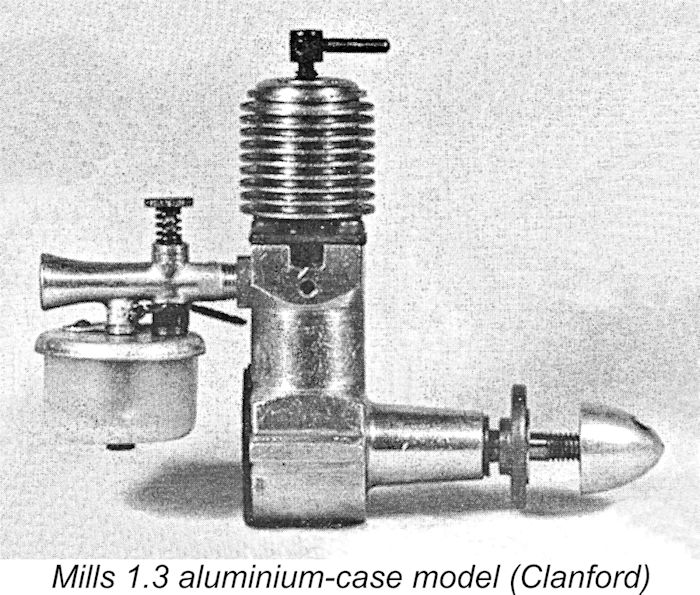 In 1948 Mills departed from their previous one-engine marketing strategy, branching out with new 0.75 cc and 2.4 cc offerings as well as a significantly revised 1.3 cc model. With all that going on, the new Mills 1.3 Marine engine which was released concurrently barely got a mention and is almost unknown nowadays.
In 1948 Mills departed from their previous one-engine marketing strategy, branching out with new 0.75 cc and 2.4 cc offerings as well as a significantly revised 1.3 cc model. With all that going on, the new Mills 1.3 Marine engine which was released concurrently barely got a mention and is almost unknown nowadays. 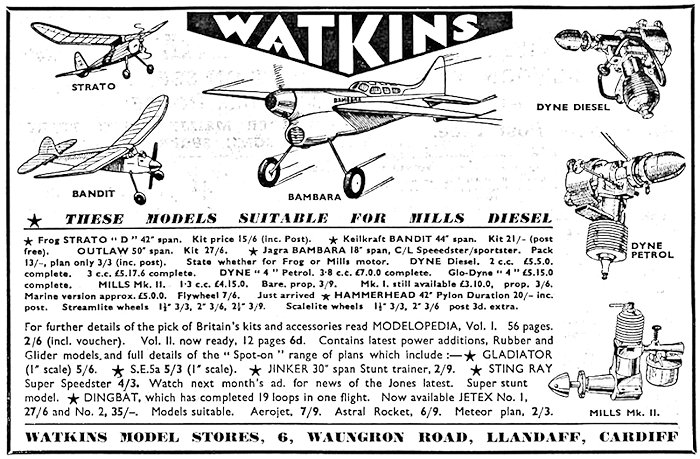 promoted it? Besides, the name suggests that there was an anniversary to be celebrated! But what anniversary?!? If the anniversary was sufficiently significant to warrant recognition, it would surely have been mentioned. The completion of two years of production of the Mills 1.3, as suggested by some?? Hardly seems to represent an anniversary worth recognizing!
promoted it? Besides, the name suggests that there was an anniversary to be celebrated! But what anniversary?!? If the anniversary was sufficiently significant to warrant recognition, it would surely have been mentioned. The completion of two years of production of the Mills 1.3, as suggested by some?? Hardly seems to represent an anniversary worth recognizing! 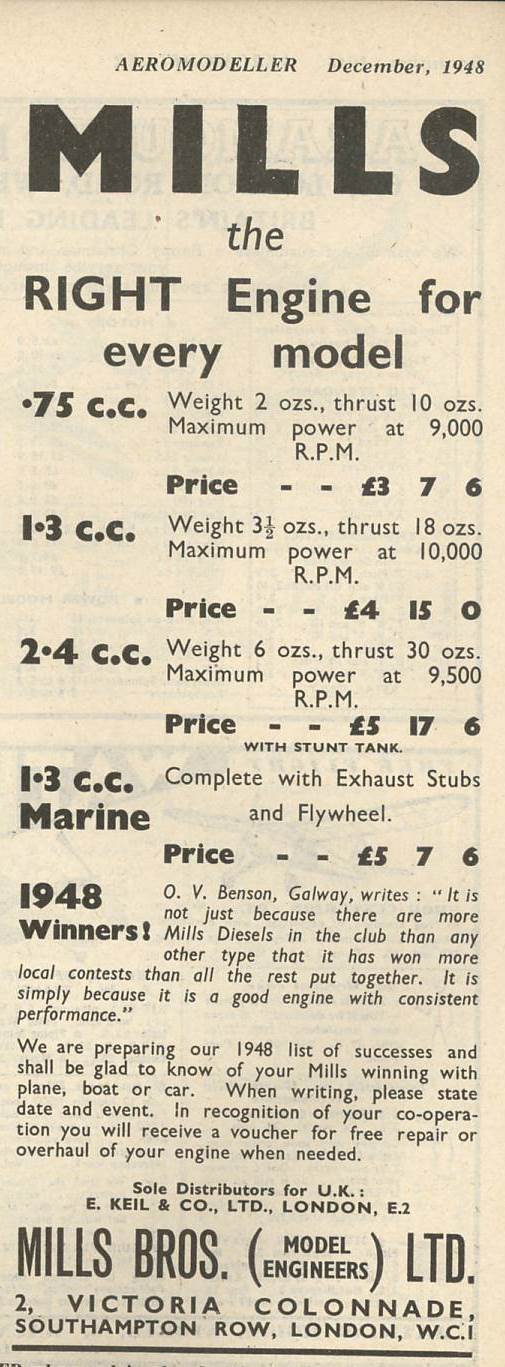 until January 1949, after which it quietly disappeared. It appears that customer response to the marine model was less than overwhelming! It's actually possible that Mills Brothers themselves may have retro-converted some of these engines back into aero configuration near the end just to facilitate their disposal to their aeromodelling-oriented customers.
until January 1949, after which it quietly disappeared. It appears that customer response to the marine model was less than overwhelming! It's actually possible that Mills Brothers themselves may have retro-converted some of these engines back into aero configuration near the end just to facilitate their disposal to their aeromodelling-oriented customers. 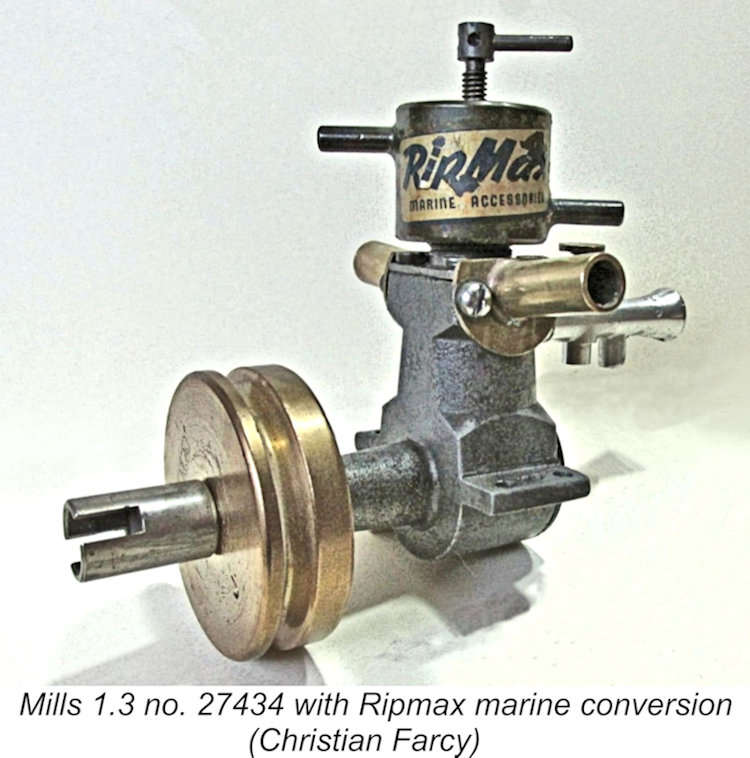
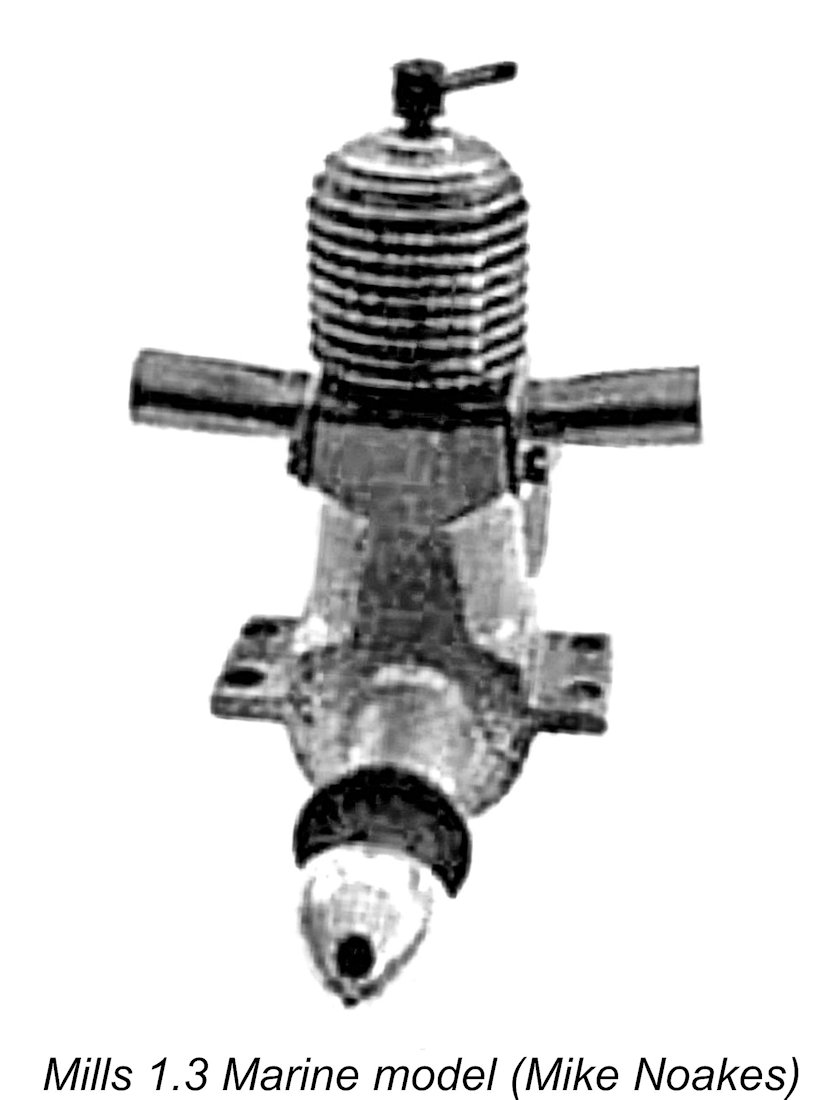
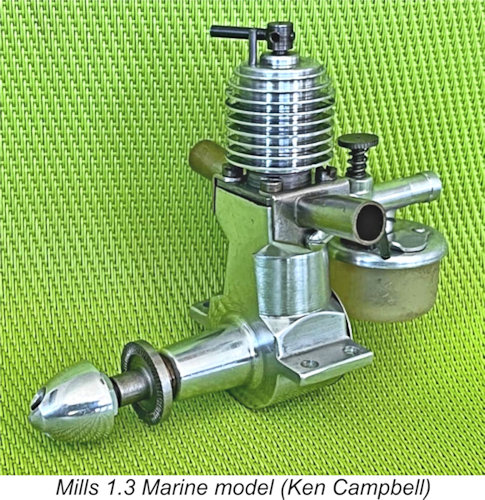 We’ll summarize our case for the Mills 1.3 “Anniversary Model” being correctly identified as an aero-converted Mills 1.3 Marine offering by reiterating the fact that no “Anniversary Model” was ever promoted by Mills Brothers. If there was an anniversary worth commemorating through the release of a “special edition”, it’s inconceivable that the manufacturers would not have promoted it. Moreover, apart from the absence of a flywheel, the aluminium-case Mills 1.3 engines are alone in featuring the provision for the attachment of a pair of exhaust stubs. These stubs were openly promoted in the context of the Marine model – they never surfaced in conjunction with any other Mills 1.3 model.
We’ll summarize our case for the Mills 1.3 “Anniversary Model” being correctly identified as an aero-converted Mills 1.3 Marine offering by reiterating the fact that no “Anniversary Model” was ever promoted by Mills Brothers. If there was an anniversary worth commemorating through the release of a “special edition”, it’s inconceivable that the manufacturers would not have promoted it. Moreover, apart from the absence of a flywheel, the aluminium-case Mills 1.3 engines are alone in featuring the provision for the attachment of a pair of exhaust stubs. These stubs were openly promoted in the context of the Marine model – they never surfaced in conjunction with any other Mills 1.3 model.